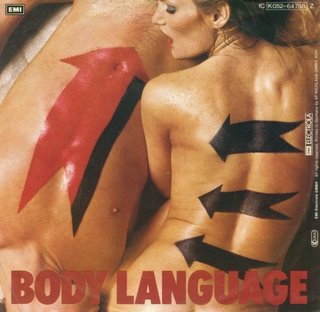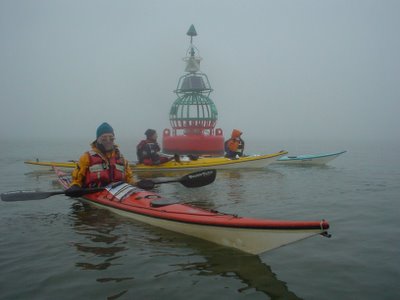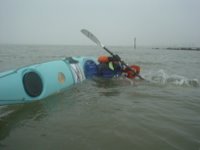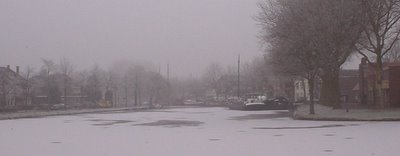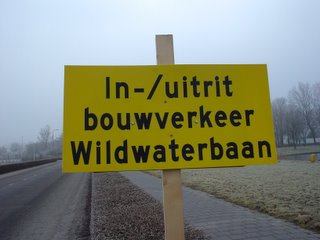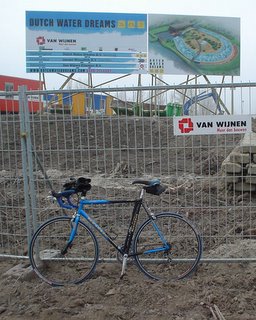
This morning I was in a shopping mood. Sometimes it just just feels good to buy yourself something nice. Is it typically Dutch to feel a little bit guilty about this? We are all human. In Dutch there is a saying: "... als je jezelf niet kietelt, doet niemand het!" I should better not try to translate it.
My shopping action was only partially spontaneous. I bought two peaces of gear. This post is about the British part I bought. That was the deliberate decision. The American bit was spontaneous.
That is a nice subject for another post.
So now I bought myself a drysuit. I have been doubting about this for a long time. Dry suits are not common in the Dutch seakayaking scene. In all the years I have been kayaking I only once met a Dutch seakayaker wearing a dry suit :
Lenze Middelberg (I am not sure if Lenze agrees, but after all those years in Svendborg I tend to call him more Danish than Dutch seakayaker?). Neoprene long johns, chillcheater underlayers and a good paddle jacket work, but there are good reasons for a drysuit: comfort and safety.
Because of this I knew few paddlers I could ask for advice. I asked Lenze,
Leon and Shawna (I met them in Anglesey 2003, preparing for their Icelandic Adventure) and they all favored the
Kokatat gear. But that is very pricy stuff, not sold in the Netherlands, and I don't like to order clothing by mail order. Above that: I might use my gear rather intensively, but that is nothing compared to what those pro's do! Somewhat simpler should do for me. With this in mind, I did my "research" on internet. The
UKseakayakguidbook and the German
Spierentonne-forum were good resources. Finally I found the Palm Sidewinder Torrent Dry Suit to come very close to my specs, and (very important) it was sold in a Dutch shop. Douglas Wilcox has written an extensive
review of the Palm drysuit.
This morning I went to
Arend Bloem: the biggest Dutch kayak retailer and probably the only one having a few drysuits in stock. Arend was surprised by my visit. He told me he normally sells about 5 drysuits in a whole year. But this week he already sold 3. Regarding this numbers Arend offers a surprising wide collection of drysuits: some Hiko-drysuits and the complete Palm collection. Palm size L was the perfect fit for me. After trying and comparing the different Palm-drysuits, I changed my mind. I choose the Sidewinder Classic in stead of the Torrent. The main reason for this is the zipper: the Torrent has a zipper on the back, the Basic over the shoulder. With the zipper over the shoulder I can open and close it all by myself. I can't manage this with the zipper on my back. To be independent is important to me! The reason why I previously set my mind on the Torrent were the sew-on booties of this drysuit. But (as Douglas) I have mixed feelings about this: pro is comfort, con is the vulnerability. And with a combination of chillcheater socks, neoprene socks and booties I never had cold feet. (I am wondering if I shoud wear the (very tight fitting) chillcheatersocks over or under the drysuit. I wonder if the latex seals make a good seal over the socks. I will try it!).
The decision was made easier by the fact that Arend sold the last Palm Sidewinder Torrent in my size one day before. And by coincidence we found out he sold it to
Hanny Kreuk, a friend of mine! Hanny and I didn't know from our mutual plans about drysuits. Now I am neither the first nor the only Dutch seakayakcoach in drysuit... I must be looking for another way to boost my reputation!
I can hardly wait to jump into the water: I want to try out my new gear! Alas: no time this weekend. I must wait till Tuesday: my paddling-evening. I will tell you how cold the water feels!
 Monsieur Bibendum, the Michelin Man, has been the chief symbol of the French tire company since he was created in 1898. Legend has it that the designer, Mr. O'Galop, was inspired by the sight of a pile of rubber tires. In his earliest incarnations, Monsieur Bibendum had many more thinner roles, as Michelin made bicycle tires at the beginning of the 20th-century; but as the company moved into the production of car tires, his shape changed accordingly. Always depicted as an active, friendly figure, Monsieur Bibendum has achieved lasting success, being both highly memorable and evocative of the product he represents.
Monsieur Bibendum, the Michelin Man, has been the chief symbol of the French tire company since he was created in 1898. Legend has it that the designer, Mr. O'Galop, was inspired by the sight of a pile of rubber tires. In his earliest incarnations, Monsieur Bibendum had many more thinner roles, as Michelin made bicycle tires at the beginning of the 20th-century; but as the company moved into the production of car tires, his shape changed accordingly. Always depicted as an active, friendly figure, Monsieur Bibendum has achieved lasting success, being both highly memorable and evocative of the product he represents.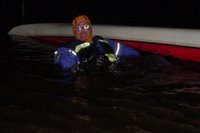 This evening I had my first paddle in the new Palm Drysuit. The conditions were perfect for testing: it was just freezing, a thin layer of ice on the kayak, water temperature about 2 or 3 degrees Celsius. After a 10 km paddling with speedy Guus, I did some rolling, re-entry and tried floating in the water. The dry part (paddling) at this temperature was comfortable. The wet part was a totally new experience: with the air trapped in the drysuit, I felt like Bibendum floating on the water. A big sensation, almost absurd, to lie so relaxed in cold water: totally dry and not freezing!
This evening I had my first paddle in the new Palm Drysuit. The conditions were perfect for testing: it was just freezing, a thin layer of ice on the kayak, water temperature about 2 or 3 degrees Celsius. After a 10 km paddling with speedy Guus, I did some rolling, re-entry and tried floating in the water. The dry part (paddling) at this temperature was comfortable. The wet part was a totally new experience: with the air trapped in the drysuit, I felt like Bibendum floating on the water. A big sensation, almost absurd, to lie so relaxed in cold water: totally dry and not freezing!


